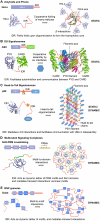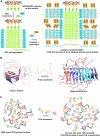The Structure and Dynamics of Higher-Order Assemblies: Amyloids, Signalosomes, and Granules
- PMID: 27203110
- PMCID: PMC4878688
- DOI: 10.1016/j.cell.2016.05.004
The Structure and Dynamics of Higher-Order Assemblies: Amyloids, Signalosomes, and Granules
Abstract
We here attempt to achieve an integrated understanding of the structure and dynamics of a number of higher-order assemblies, including amyloids, various kinds of signalosomes, and cellular granules. We propose that the synergy between folded domains, linear motifs, and intrinsically disordered regions regulates the formation and intrinsic fuzziness of all higher-order assemblies, creating a structural and dynamic continuum. We describe how such regulatory mechanisms could be influenced under pathological conditions.
Copyright © 2016 Elsevier Inc. All rights reserved.
Figures



References
Publication types
MeSH terms
Substances
Grants and funding
LinkOut - more resources
Full Text Sources
Other Literature Sources

